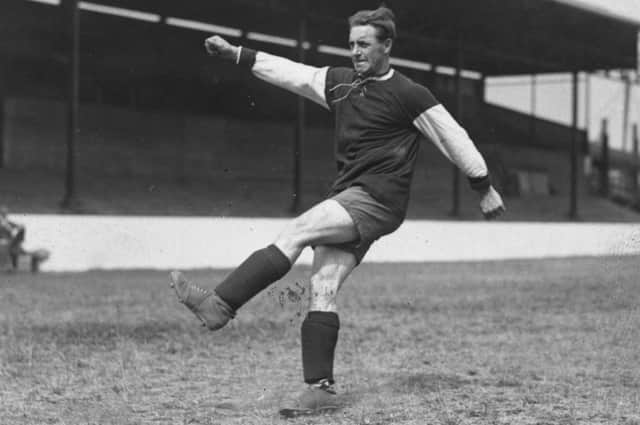What a difference a century's made for Falkirk in football transfer market


Those three questions were asked by the Football Post back in 1922, but they could equally have been posed now following the closure of the latest transfer window, colossal quantities of cash having been splashed once again.
Maybe it has always been so, and it is just the march of time that has triggered increasing fees for footballers.
Advertisement
Hide AdAdvertisement
Hide AdIn the past, football annuals used to include transfer trails listing firsts for players setting new record price-tags – past £1,000, then £2,000, then £3,000 and so on until the Monopoly money men took over.


Scottish clubs have featured at certain stages in setting such transfer records but inevitably as sellers rather than buyers.
Only once did a Scottish club feature in such a list as the buying club and it was not one of the so-called bigger clubs.
The club that hold that unique place in the history of football transfer records are Falkirk, currently still in the third tier of Scottish football.
Advertisement
Hide AdAdvertisement
Hide AdThe story of the Syd Puddefoot transfer is an amazing tale that would never be repeated in these days of social media, wall-to-wall TV and internet coverage, football agents and round-the clock rumour and speculation.
The events of February 1922 are quite simply incredible, and no scriptwriter could have dreamt up the story behind the transfer of Puddefoot from West Ham to Falkirk.
It was 100 years ago, and it still seems like make-believe.
Along with all other football clubs, Falkirk had struggled during the First World War and their line-ups back then often featured old Brockville favourites and guest players from other clubs in the neighbourhood on military service.
One such guest was Puddefoot. The West Ham forward, born in Limehouse in London in 1894, had worked in a munitions factory and was not called up for military service until near the end of the war.
Advertisement
Hide AdAdvertisement
Hide AdHe joined the Royal Fusiliers and was posted to Scotland, based at Bridge of Allan in Stirlingshire.
While stationed there, Puddefoot made six appearances for Falkirk in during the 1918/19 season as a centre-forward, scoring five goals. He played against Airdrie, Hibs, Clyde, Dumbarton, Morton and Third Lanark, becoming an instant fans’ favourite.
After the end of the war, football took a while to get back to normal and Falkirk’s league positions did not exactly inspire confidence.
There was little consolation to be found in the Scottish Cup either and their cup win of 1913 was fast becoming a distant memory.
Advertisement
Hide AdAdvertisement
Hide AdThe next piece of news to come from Brockville raised hopes of future success, however – Falkirk signing Puddefoot from West Ham.
Puddefoot was one of the most promising players in English football and had been with West Ham since he first signed for them as an amateur. The Hammers were his local team, and he’d soon made an impact rattling in goals as part of a strong side.
Several big clubs were chasing his signature and inevitably Puddefoot would soon be on his way for a then world record fee.
His destination in February 1922, a century ago on Monday this week, to the astonishment of the whole footballing world, was Scotland – and Falkirk in particular.
Advertisement
Hide AdAdvertisement
Hide AdWest Ham issued a statement in an attempt to appease their angry fans, but it met with little success.
“The departure of Syd Puddefoot came as no surprise to those intimately connected with him,” said a spokesmen for the London side.
“It is an old saying that everyone has one chance in life to improve themselves and Syd Puddefoot is doing the right thing for himself in studying his future.
“We understand that he will be branching out in commercial circles in Falkirk and, when his football days are over, he will be assured of a nice little competency.”
Advertisement
Hide AdAdvertisement
Hide AdAt that time, the record fee paid for a player was £4,600 for Kilmarnock’s Tom Hamilton moving to Preston North End in 1921, the ever-increasing cost of football transfers being well under way already.
There were many rumours surrounding the Puddefoot transfer, some of which I wanted to be true.
For the true story, we need to rely on the contents of the minute book of directors’ meetings in 1922.
The minutes of February 9’s meeting make interesting reading: “The secretary (manager Willie Nicol) reported the steps taken to secure the transfer of Sydney Puddefoot from West Ham United and in connection therewith read the letter received from Puddefoot stating he was likely to be on the transfer list.
Advertisement
Hide AdAdvertisement
Hide Ad“The chairman had signed a statement that the directors were willing to go to the length of £5,000 for the transfer.
“The secretary had gone to London and had arranged the transfer for £5,000, the player to receive £1,000 and his terms being £10 per week with a bonus of £2 for a win and £1 for a draw.
“It was agreed to raise the amount necessary by loans.”
West Ham had asked for a fee of more than £4,500, claiming they had already turned down that amount from Tottenham Hotspur. How good a poker player Nicol was we will never know, but the asking fee was easily matched and the deal completed, with something to spare.
Amazingly, Puddefoot had approached Falkirk first. There was no medicine bag full of cash.
Advertisement
Hide AdAdvertisement
Hide AdVarious accounts have suggested reasons for the surprise move. Some said Puddefoot was disillusioned by the overtly physical nature of the game in the English Second Division, while others hint at a more financial reason, namely the maximum wage limitations then in force.
West Ham had also spent a considerable sum, rumoured to be around £35,000, on ground improvements.
Footballers in England were subject to a wage cap of £9 per week and there was reportedly interest from Chelsea, Arsenal and Spurs in signing the free-scoring forward.
The terms on offer from Falkirk were extremely generous and a £1,000 signing-on fee was obviously attractive. How Falkirk had pulled off that deal is beyond belief, though, as it is clear that they did not have access to funds of that nature.
Advertisement
Hide AdAdvertisement
Hide AdWhatever the real reasons for Puddefoot’s move here we will never know, but the player knew Falkirk well and certainly knew what lay ahead in professional terms. Maybe he felt a successful spell in Scotland could force a bigger move later in his career.
Once in Falkirk, Puddefoot was paraded around the town in an open-top carriage, and few could believe that Falkirk had set a new world transfer record for a footballer.
Crowds gathered at Grahamston Station to see the arrival of a player they hoped would bring much longed-for success.
His first game was to be a Scottish Cup second-round tie at Bathgate, then a Second Division side and doing well. Falkirk lost 1-0.
Advertisement
Hide AdAdvertisement
Hide AdThat cup defeat was the only real low point of a great season and, but for some silly losses, the club could have finished even higher. They ended up in fifth place, but one more win could have seen them finish third, behind the Old Firm.
Still, they had gone through a season without losing to the two big Glasgow teams, quite an achievement in itself.
Puddefoot’s Falkirk career was to see him enhance his reputation as a goal-scorer, but there were stories that he was not entirely happy in Scotland.
There had been rumours of scouts from top English clubs including Liverpool, Arsenal and Blackburn attending Falkirk games to assess Puddefoot’s form, and it seemed a matter of when, rather than if, he would be lured back south.
Advertisement
Hide AdAdvertisement
Hide AdA game against Raith Rovers on Saturday January 31, 1925, was to be his last in Falkirk colours, and fittingly he scored in that 1-1 draw.
The following Tuesday, representatives of Blackburn Rovers met the Falkirk board and negotiated a transfer fee of £4,000. All in all, it was a good bit of business for Falkirk.
Puddefoot’s move to Scotland, while initially attractive, had left him homesick and few were surprised when he chose to move to Lancashire.
Falkirk’s tenure of the world transfer record, currently held by Neymar’s switch from Barcelona to Paris Saint-Germain for £190m in 2017, did not last too long as Warney Cresswell moved from South Shields to Sunderland for £5,500 later in 1922. The upward spiral had started.
Comment Guidelines
National World encourages reader discussion on our stories. User feedback, insights and back-and-forth exchanges add a rich layer of context to reporting. Please review our Community Guidelines before commenting.